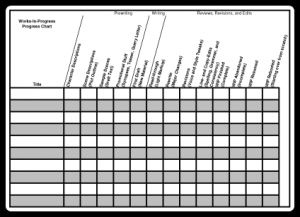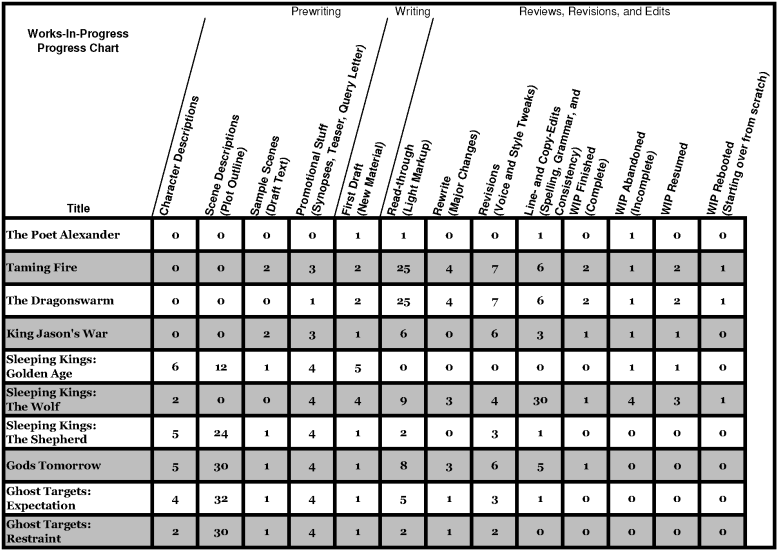
Track the status of your projects as they move from shapeless rocks to beautiful works of art.
WIPs, or Works-in-Progress, are often the favorite topics of creative writers. I realize now I was a fool to wait so long to invite you to talk about yours!
That’s this week’s Creative Writing exercise, though. In light of our recent discussion of the various stages of manuscript development, I want you to tell me what you’ve done. Have you written a first draft? Have you toiled through a month of prewriting and put 30,000 words on the page before your project’s inner fire flickered out? Have you finished six novels and hundreds of rounds of rewrites?
Let me know. If you’ve only got one WIP, tell me where you are with that one. If you’ve done more than one, chart it out. It can be amazingly useful to compare the different stages of writing and where you’ve spent your time on different projects. Compare the amount of prewriting you did to the amount of revision your manuscript needed, or to how many times you abandoned it along the way. Compare how many times you shared your document out for feedback with your completion rate.
Here’s a list of some of the things I’ve found useful:
Prewriting
How much prewriting did you do? If you want to sum up your prewriting in one sentence (“I did a lot of prewriting,” or “Prewriting is for pansies!”), feel free. I’ve been putting a bigger focus on prewriting in the last year or two, though, so for my chart, I broke it down into the major categories I’ve found important.
- Character Descriptions. How many characters did you get sorted out before you started writing your WIP?
- Scene Descriptions. How many scenes did you figure out before you started writing? I’m usually satisfied with a 1-2 paragraph description of what happens in the scene. (If you’re not used to working in scenes, you can count chapters instead.)
- Sample Scenes. How many scenes did you write before you settled into writing the whole manuscript? This can include prologue scenes that didn’t make it in the final cut, exciting excerpts, or even brief stories about your characters or setting that were never meant to be a part of the finished manuscript.
- Promotional Stuff. How many different ways did you try to describe your story idea? This includes both short and detailed plot synopses, teaser scenes, and even query letters.
Writing
How many times did you go back to the manuscript to write new material? This includes complete rewrites (I’ve had several novels where I threw out huge chunks of the source material and rewrote whole chapters from scratch), as well as major additions. If you’re not writing out at least a whole scene at a time, count it as “Rewrite” in the following category.
Reviews, Revisions, and Edits
I said yesterday that this is the part where you actually make your work of art, and it shows in the number of categories I give it. If you want to keep it brief, tell me how many times you’ve revised your document (reading through from start to finish, and making any changes at all). Tell me how many people you’ve shared it with, and if it’s finished now.
If you want to go into detail, these are the categories I used for my chart:
- Read-through. How many times have you read the document from start to finish, with a focus on the reader’s experience (so only stopping to make minor notes or corrections along the way)?
- Rewrite. How many times have you rewritten the document, making major changes to characters or plot? In my experience, most novels need at least one big rewrite, backfilling all the material you found out you needed by the end of the first draft, that you couldn’t have possibly known about when you first started.
- Revisions. How many times have you gone through the document deliberately trying to improve the story’s flow? This is where you make changes to voice and style that give your document polish and shine.
- Line- and Copy-Edits. How many times have you crawled through your document, an inch at a time, checking every sentence for grammatical errors, every word for typos? It’s a grueling process, and once you’re rich and famous you’ll be able to pay people to do this part for you, but until then it’s an important part of the process. (If you’ve got great test readers who catch a lot of your errors for you, you can certainly count their feedback in this column).
Dedication
In my chart I forgot to separate this into its own section, but it’s some of the information I find most useful, looking back through my old projects and trying to keep up with my current ones. For each project, tell me if it’s finished to your satisfaction, unfinished-but-in-progress, or unfinished and totally abandoned.
I’ve been working on this long enough that it’s insufficient to just say which state a project’s in now — I need to keep track of how many times it’s been in each state.
- WIP Finished. How many times have you decided, with absolute certainty, that your project was finished, and you had no more work to do on it (apart from shopping it to editors and agents, anyway)?
- WIP Abandoned. How many times have you decided, with absolute certainty, that your project was a complete waste of time, and not worth working on ever again? (To avoid artificial inflation, I only count the times that decision persisted for more than a week.)
- WIP Resumed. How many times have you returned to your abandoned or languishing project and made real progress again?
- WIP Rebooted. How many times have you returned to your abandoned or languishing project, skimmed over it to find the really great material, and then threw the bulk of it in the trash and started over from scratch? It’s an agonizing process — even worse than starting from nothing — and anyone who can get from WIP Rebooted to WIP Finished deserves a gold star.
So! Those are all the factors that I think matter. Feel free to add or subtract, and figure out where you stand with all your current writing projects. It can be a great motivator, but it can also be a valuable analytical tool. Keep your chart up to date, and it will help you learn where you lose interest, where you get your best work done, and which processes to avoid in your own writing career.
In case you’re curious, here’s mine (with some best-guess estimates on the older projects).

My current works in progress, in all their glory
If that chart looks like it would actually be useful to you, you can get a PDF here (better for printing), or download the Excel spreadsheet template (in case you want to make some changes).
Feel like sharing yours? Tell us about it in the comments, or start a new thread over on the discussion board.






Thanks for the chart!
I know a lot more about prewriting now, so with the next novel I’m doing much more prep. For the last one the only thing I had done was defining characters, and it was only a few sentences each.
I really enjoyed your “Reviews, Revisions, and Edits” section…It gives me a much better idea of how to go back through my blog posts before I publish. Emphasizing each of these foci on separate reads would make a big difference. I tend to space out a little when I re-read a blog post for editing purposes. I catch stuff, and revise, but not as well as I could. I think this will help a lot.
@Rebecca Campbell,
It’s worked for me! Obviously different writers have different styles, but it shows pretty clearly in the chart above that once I started taking prewriting seriously, I never looked back.
For me it works well to divide the parts of creating a novel into clear groups — coming up with a solid idea and cast of characters, writing the story, and then polishing it. When I’m having to make up major plot points or character details as I go, I just can’t put the same attention into my write.
I know writers who only do it for the thrill of discovery, though, so for them prewriting takes all the fun out of it.
Carlos,
Obviously you’re not going to put in twenty-five read-throughs on a thousand-word blog post, when you have another deadline looming late in the week, but I definitely think dividing it up could help — even if it’s just dedicating one revision to spelling and grammar, and another one to voice and style.
Definitely keep me posted. Let me know how that approach works for you.